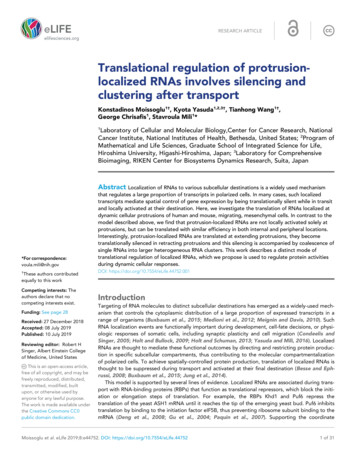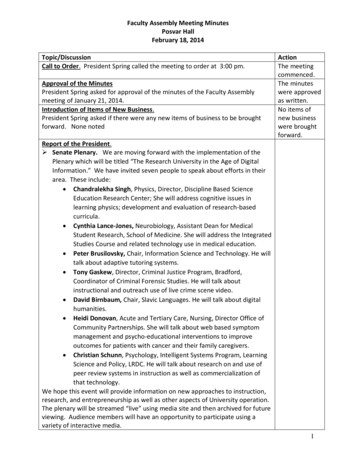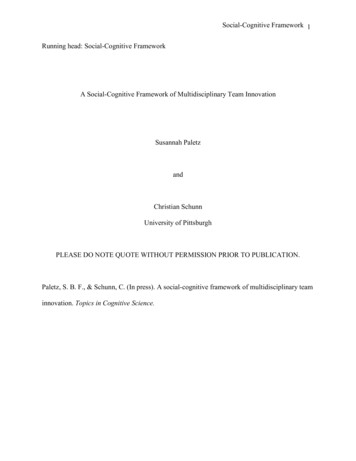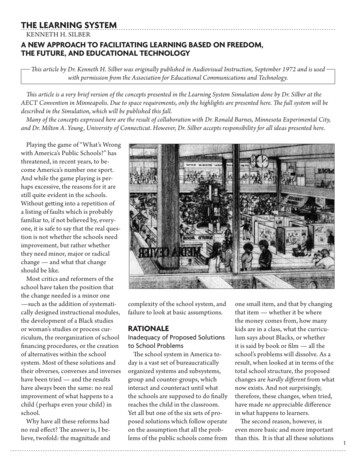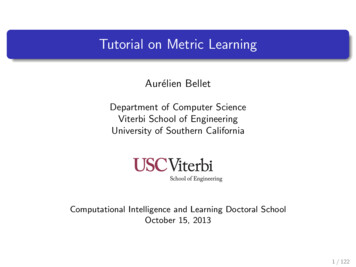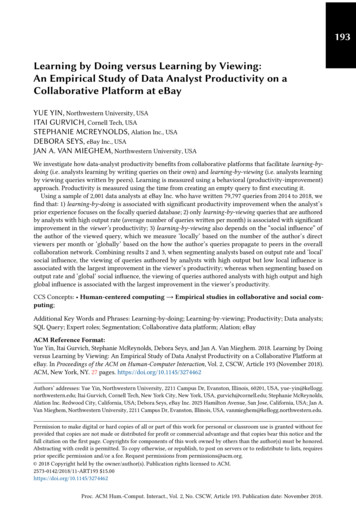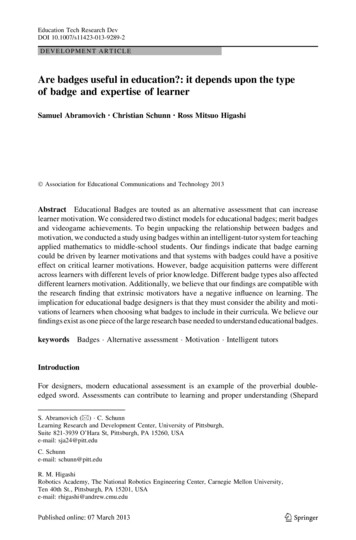
Transcription
Education Tech Research DevDOI 10.1007/s11423-013-9289-2DEVELOPMENT ARTICLEAre badges useful in education?: it depends upon the typeof badge and expertise of learnerSamuel Abramovich Christian Schunn Ross Mitsuo HigashiÓ Association for Educational Communications and Technology 2013Abstract Educational Badges are touted as an alternative assessment that can increaselearner motivation. We considered two distinct models for educational badges; merit badgesand videogame achievements. To begin unpacking the relationship between badges andmotivation, we conducted a study using badges within an intelligent-tutor system for teachingapplied mathematics to middle-school students. Our findings indicate that badge earningcould be driven by learner motivations and that systems with badges could have a positiveeffect on critical learner motivations. However, badge acquisition patterns were differentacross learners with different levels of prior knowledge. Different badge types also affecteddifferent learners motivation. Additionally, we believe that our findings are compatible withthe research finding that extrinsic motivators have a negative influence on learning. Theimplication for educational badge designers is that they must consider the ability and motivations of learners when choosing what badges to include in their curricula. We believe ourfindings exist as one piece of the large research base needed to understand educational badges.keywordsBadges Alternative assessment Motivation Intelligent tutorsIntroductionFor designers, modern educational assessment is an example of the proverbial doubleedged sword. Assessments can contribute to learning and proper understanding (ShepardS. Abramovich (&) C. SchunnLearning Research and Development Center, University of Pittsburgh,Suite 821-3939 O’Hara St, Pittsburgh, PA 15260, USAe-mail: sja24@pitt.eduC. Schunne-mail: schunn@pitt.eduR. M. HigashiRobotics Academy, The National Robotics Engineering Center, Carnegie Mellon University,Ten 40th St., Pittsburgh, PA 15201, USAe-mail: rhigashi@andrew.cmu.edu123
S. Abramovich et al.2000) through providing necessary formative feedback as well as additional ways to gaugestudent learning. But over-assessment and inaccurate assessment have clear negativeconsequences on motivation (Stiggins 2002). Students who are over-assessed can becomemotivated to seek mastery of exams rather than genuine learning. Inaccurate assessment isdangerous in that it can cause a drop in motivation to learn for a student who thought theywere learning but is provided feedback that contradicts their self-assessment. Becausemotivation is known to be key to learning (Clark et al. 2006), the potential benefit of anassessment is determined by its ability to both maintain learning motivation and accuratelycommunicate a student’s learning.Educational reformers have looked to alternative assessments as a means to maximizethe benefits of assessments while minimizing negative effects (Stiggins 2005). Movingaway from the culture of standardized testing allows more options for instructionaldesigners in the construction of assessments that permit a wider variety of feedback anddata to students and teachers.One alternative assessment that has begun to gain traction among reformers andinstructional designers is educational badges (Alberts 2010). Badges, much like theircounterparts in scouting and videogames, are seen as a way to assess learning outside offormal schooling. The issuers of educational badges—an educator or educational organization—can give a symbolic award for any type of skill, knowledge, or achievement similar tohow they currently provide degrees or certificates. The symbol, in the form of a badge, canthen be displayed by the learner to let others know of their mastery or knowledge. Therefore,instructional designers can use educational badges to influence engagement and learning. Forexample, badges can provide focused goals, challenging tasks, clear standards, affirmation ofperformance, novelty, choice, and authenticity (Dickey 2005).The implementation of educational badges is already underway by many organizationssuch as Mozilla (Peer 2 Peer University and Mozilla Foundation 2011) and the KhanAcademy. However, there is little research that examines how badges interact with studentmotivation. While badges might provide the type of formative feedback valued in alternative assessment, badges could also be a negative influence through decreasing a student’smotivation to learn. For example, earlier research about other kinds of rewards has regularly found that external rewards are bad motivators for learning (Deci et al. 1999). Iflearners interpret badges as external rewards, then they could possibly lower a student’smotivation to learn or cause the student to focus on earning badges to the exclusion of thelearning goals.In order to begin unpacking the possible bi-directional relationships between educational badges and learning motivation, we conducted a study using badges within anintelligent-tutor system for teaching applied mathematics to middle-school students. Weinvestigated how learner motivation changed with exposure to badges and how learnermotivations shaped badge acquisition.Theoretical backgroundAlternative models of badgesBadge advocates claim that badges can be offered as an alternative assessment that willincrease learner motivation while maintaining high-quality feedback (Davidson 2011). Tounderstand where these claims originate, let us consider the two distinct models for educational badges: merit badges and videogame achievements.123
Are badges useful in education?Merit-badges, a feature of the United States’ Boy and Girl Scout organizations, offersparticipants the chance to earn certification (i.e. a Badge) of specific knowledge or skillsnot usually addressed by formal educational systems. Children select which badges theywant to earn, under the theory that the goal of earning a badge will trigger an increase inmotivation for those learners who want formalized recognition. Additionally, a scout’sdisplay of their earned badges represents a type of curriculum vitae of their learning andallows others to learn both what a scout knows and what the scout values.The second model of badges is based on meta-gaming features common to videogames.Many best-selling videogame systems allow players to earn recognition of their in-gameachievements outside of the game itself. For example, Xbox players have a virtual profiledisplaying their different game accomplishments for others to see. These achievements (i.e.badges) are awarded to players while playing a game but have no direct effect on playother than being designed to encourage more play. Within the Xbox ecosystem, a playercan compare their achievements with those earned by their friends and peers. Player canchoose to earn specific badges but also can earn a badge incidentally through normal gameplay.Educational badges share many of the same features of the merit-badge and video-gamemodels. Like merit badges, educational badges are commonly offered for learning thatoccurs outside of traditional educational institutions (e.g. community building, online literacy). Educational badges are commonly viewable on a learner’s online profile by alearner’s peers, similar to how videogame badges are viewable to other players and howscouts display badges on sashes. Similar to videogame achievements, badges can beawarded for incidental activity in addition to mastery of skills or demonstration ofknowledge.An example of an educational badge system is Carnegie Mellon University’s ComputerScience Student Network (CS2N; http://www.cs2n.org). CS2N is an online learning systemin which participants can earn badges while developing computer-science skills andknowledge. Although computer science courses can be found in some public schools,CS2N cover aspects of computer science that are often skipped (e.g. animation, robotics).Each CS2N user has a profile page on which they can see the badges they have earned aswell as potential badges they might wish to earn. The variety of educational applicationsavailable in CS2N (e.g. intelligent tutors, virtual robots, learning management systems) ona variety of topics (e.g. algebra, programming, movie making) provides students a breadthof badges to pursue. Within each application, badges are awarded for progress towardmastery as well as continued participation.Psychological theories of learner motivationBecause motivation and assessment are intertwined, to understand the educational potentialof badges requires understanding of how badges affect learning motivation. In the past15 years, a particularly successful theory for studying motivation and learning isachievement goal theory (Elliot 1999). Achievement goal theory frames motivationallearning goals into four different types organized into a 2 9 2 matrix of mastery andperformance crossed with approach and avoidance. Mastery approach goals reflect a desireto achieve mastery based on one’s own interest. Performance approach goals reflect adesire to perform demonstrably better. Performance avoidance goals reflect the desire toavoid the appearance of underperforming. Mastery avoidance goals, while existing theoretically, do not manifest in most real-world contexts. Research typically finds a positivecorrelation between mastery learning and academic performance outcomes and a negative123
S. Abramovich et al.correlation between performance avoidance and academic outcomes (Elliot et al. 2006).Performance approach goals have had mixed outcomes, depending on other variables(Elliott et al. 2005). Overall, achievement goal orientation has proven to be a good predictor of academic performance in various academic subjects (Pajares et al. 2000). Forexample, mastery goals were found to positively correlate with student use of cognitivestrategies while performance approach goals positively correlated with teacher-assignedgrades (Wolters 2004). Because badges, at first glance, have performance and masteryelements, achievement goal theory may be a useful way of unpacking the effects ofeducational badges on learning-relevant motivations.It is important to note that achievement goal theory is only one well-established theoryof learning motivation. Another established theoretical framing of motivation is expectancy-value theory (Wigfield and Eccles 2000). How a student expects to perform in asubject is known to be an independent predictor of achievement. For example, studentswith low confidence in their math ability are more likely to guess an answer to a mathquestion rather than work to solve it (Beal et al. 2008). Additionally, the level of interest ofa student has in a subject (intrinsic value) can also independently predict future learning.For example, students who are interested in math will continue to enroll in math relatedcourses, increasing their opportunity to learn relative to students less interested in math(Pintrich 2003). Educational badges, in addition to potentially changing a learner’sachievement goals, might also change how much the learner values a subject (by havingthem choose goals to pursue) or what their expectations are for success (by regularlyflagging success or lack thereof).Interactions between learner prior knowledge and badgesThe ways in which learners react to badges may depend upon a range of prior experienceswith the domain being badged. Prior knowledge and its interaction with other studentcharacteristics can have a major influence on assessment performance (Dochy et al. 1999).In addition to having built up particular achievement goals, interests, and expectations forsuccess, a learner will have prior knowledge levels that will shape how quickly and easilybadges are earned, which then may also shape how much the learner values these badges.Therefore we examine whether prior ability levels moderate the relationships of badgeearning with learner motivations.MethodsParticipants36 seventh graders and 15 eighth graders at a charter school serving a low-income suburbof a large east coast city in North America participated in our study.MeasuresTo measure achievement goal orientation, we used a version of the patterns of adaptivelearning scales (PALS) survey instrument (Midgley et al. 2000) modified to measuremotivation related to the content area focus of the study, math. The measures of Masterygoals (e.g. ‘‘One of my goals this year is to master a lot of new skills in Math.’’),123
Are badges useful in education?Performance Approach goals (e.g. ‘‘It’s important to me that I look smart compared toothers in Math.’’), and Performance Avoidance goals (e.g. ‘‘One of my goals in Math is toavoid looking like I have trouble doing the work.’’) contained four questions each withanswers in a Likert Scale from 1–5. Pre Cronbach alphas for mastery goals, performanceapproach, and performance avoidance were 0.82, 0.81, and 0.68 and post alphas were 0.81,0.84, and 0.66.To measure the key constructs from expected value theory, we used five questions withanswers in a Likert Scale related to expectancy (e.g. ‘‘If you had to take an important mathtest today, would you do well?’’), and two questions related to interest (intrinsic value, e.g.‘‘In general, I find working on math assignments very interesting.’’) that were adapted froma variety of studies (Beal et al. 2008; Wigfield 1994; Wigfield and Eccles 2000). Motivation and interest alphas, respectively, were 0.81 and 0.83 for pre measures and 0.78 and0.82 for post measures.To determine if badge interaction with learning motivation was different for studentswith different levels of skills, we used a pretest of proportional reasoning that has beenvalidated for this age group and focuses on the exact skills taught in the tutor (Weaver andJunker 2004). We divided the students in the study into two groups based on a mean splitof the number of pre-assessment math problems correct. The low-performing students hada range of correct problems from 3 to 10. High-performing students had a range of 11–16problems correct.Students’ opinions on badges were measured using questions previously established inan earlier study (Abramovich et al. 2011) which in turn were created through several pilotstudies. Because of the relative newness of educational badges, we are unaware of anyother badge specific opinion questions used in prior research.ProcedureWe measured pre-ability and pre and post motivational levels around the use of the CS2Nintelligent tutoring system. Students earned various forms of badges in the CS2N intelligent tutoring system and were notified of all awarded badges through a dialogue box withinthe tutor interface (Fig. 1). Students were initially unaware of the available badges butFig. 1 Examples of participation (left) and skill (right) badges in the CS2N intelligent tutor123
S. Abramovich et al.would compare and converse with each other about the different type of badges they hadearned.The intelligent tutoring system builds upon a Cognitive Tutor approach developed atCarnegie Mellon University and deployed in thousands of schools (Anderson et al. 1995).The tutor could provide hints when students were stuck and kept track of skills beingmastered based on successfully solving particular solution steps associated with each skill,but doing so without error or hint. The content area focus of the particular unit calledrobots in motion was proportional reasoning, understood to be a foundation for mathematics, science, and engineering education (Silk et al. 2010).Students spent on average 20 min each school day with the tutor over *1 monthperiod. They learned how to use various mathematical reasoning strategies to program arobot to move certain distances and turn certain angles in the context of trying to solve alarger problem involving controlling a robot on a distant asteroid, eliminating the guessand-check methodology commonly employed by novice roboticists (see Fig. 2 for anexample task page).In the particular version of CS2N and the intelligent tutor that was studied, badges weregranted based on metrics related to progress within the tutor and mastery of measuredskills. Accordingly, we classified the badges awarded by the tutor into two distinct categories (Table 1): those indicating mastery of skills and those reflecting participation in thesystem. Prior testing had indicated the potential for badges to re-motivate students whosefrustration level was increasing while using the tutor (Abramovich et al. 2011).Fig. 2 Example tutor page. On this page, students respond via pull-down menus, whereas on some otherpages, students type in number responses or free text explanations. When students click on the hint button,hints are shown in the hints window123
Are badges useful in education?Consequently, we theorized that badges awarded for participation, regardless of the qualityof the user’s performance, would provide increased motivation to all users. Badges thatwere awarded based on mastery of skills within the tutor were aligned with the theory thatbadges can act as an alternative assessment. Because of their different theoretical functionswith respect to motivation and learning, we separately examined correlations with numberof participatory badges and number of skill badges. In addition, exploratory factor analyseson badge earning data suggested there are two underlying dimensions of skill and participation (see Table 1 for the list of each).Our research questions were:1. Do badges have a different motivation relationship for different ability learners?2. Do different types of badges have different motivation relationships with learners?Table 1 Badges available in the CS2N Intelligent tutoring system and number earned overall and by levelof learnerDescriptionCategoryNumber earnedHPLPCorrect a mistake in less than 2 minSkill502723Complete a problem with no errors in less than 5 minSkill512823Complete a problem with no errors in under 1 minSkill512823Find distance using scale factorSkill15114Find distance using unit rateSkill19127Find power using scale factorSkill14113Find power using unit rateSkill880Count half of a turnSkill000Count a whole turnSkill110Measure with non-zero aligned startSkill220Measure with zero aligned startSkill220Measure remainderSkill00030 min of cumulative cognitive tutor timeParticipatory50272360 min of cumulative cognitive tutor timeParticipatory492722120 min of cumulative cognitive tutor timeParticipatory382612180 min of cumulative cognitive tutor timeParticipatory23177300 min of cumulative cognitive tutor timeParticipatory000Answer 25 questions correctlyParticipatory502723Answer 50 questions correctlyParticipatory482721Answer 75 questions correctlyParticipatory462719Answer 100 questions correctlyParticipatory442717Answer 200 questions correctlyParticipatory302010Answer 5 questions correctlyParticipatory512823Correct a mistake in under 5 minParticipatory502723Complete a page with a mistake in at least 10 minParticipatory331914Complete a page with an error in at least 15 minParticipatory1596Getting a hintParticipatory452619HP badges earned by high math performers, LP badges earned by low math performers123
1233.4 (1.2)Interest* p \ 0.05; ** p \ 0.013.5 (1.0)3.8 (0.8)Performance avoidance3.4 (1.0)Expectancy4.5 (0.5)Performance approach4.2 (1.0)4.6 (0.4)2.8 (1.2)3.2 (1.3)4.6 (0.7)3.8 (1.2)4.2 (0.7)3.1 (1.2)3.3 (1.2)4.6 (0.7)3.8 (1.2)3.9 (0.7)3.0 (0.9)3.4 (1.0)4.5 (0.8)LowAllLowHighPostPreMasteryMeasureTable 2 Mean pre, post, and change in motivation measures (with S.D.)4.3 (0.9)4.6 (0.3)2.7 (1.2)2.8 (1.3)4.6 (0.7)High4.1 (1.1)4.3 (0.7)2.9 (1.1)3.1 (1.2)4.5 (0.8)All0.4* (0.9)0.1 (0.5)-0.5** (0.7)0.0 (0.9)0.0 (0.7)LowChange0.1 (0.7)0.0 (0.4)-0.1 (0.9)-0.4 (1.0)0.0 (0.4)High0.3* (0.8)0.1 (0.4)-0.2* (0.8)-0.2 (1.0)0.0 (0.5)AllS. Abramovich et al.
Are badges useful in education?Fig. 3 Mean pre- and postscores(with SE bars) on performanceavoidance and interest measuresfor low and high math pre-testgroups.**p \ 0.01, *p \ 0.05FindingsAggregate analyses across all learnersAnalysis of all students (n 51) revealed a few small overall changes in motivations.Paired sample t-tests of pre to post changes revealed a 0.25 decrease (on the 1 to 5 scale) inperformance avoidance motivation (t 2.06, p \ 0.05, Cohen’s d 0.29) and a 0.25increase in interest (t 2.34, p \ 0.05, Cohen’s d 0.33). Overall, students who used thecognitive tutor became less concerned about poor performance relative to other studentsand became more interested in math.To discover if badges interacted with learning motivation (i.e. were predicted by premotivation levels or were associated with changes in motivation levels), we conductedPearson correlations between the number of participatory badges earned and the differentmeasures of pre motivation, prior ability, and pre-post changes in motivation. Pre measuresof motivation and number of math problems correct did not correlate with the total numberof badges earned by students. However, the total number of badges earned did correlatewith an increase in performance avoidance motivation (r 0.30, p \ 0.05). The morebadges a student earned indicated less of an overall decrease in the same student’s concernabout their performance. Based on these limited findings, we might have concluded thatwhile the cognitive tutor might have had a positive effect on some learning motivation, theinclusion of badges possibly has a negative effect on learning. However, we furtherunpacked our findings, looking for whether the effects are actually specific to particularstudent subgroups and/or badges types.Do lower performing students and higher performing students see different motivationchanges?As shown in Table 2, for the low-performing students (n 23), we discovered that performance avoidance motivation (e.g. One of my goals in Math is to avoid looking like Ihave trouble doing the work.) decreased by 0.48 (t 3.49, p \ 0.01, Cohen’s d 0.73)123
S. Abramovich et al.Table 3 Pearson correlations (and p values) between motivation pre measures and skill and participatorybadges earning for all users and separately by math performance levelsPre measuresSkill badgesAll usersParticipation badgesHPLPAll usersHPLPMastery0.19 (0.18)0.13 (0.50)0.24 (0.26)0.19 (0.21)0.16 (0.43)0.19 (0.39)Performanceapproach-0.06 (0.68)-0.13 (0.53)0.23 (0.30)0.06 (0.68)-0.17 (0.38)0.48* (0.02)Performanceavoidance-0.34* (0.01)-0.39* (0.04)0.09 (0.67)-0.22 (0.12)-0.32 (0.10)0.10 (0.65)Expectancy0.14 (0.34)-0.36 (0.06)0.07 (0.74)0.18 (0.21)-0.07 (0.72)0.08 (0.73)Interest0.27 (0.06)0.27 (0.16)-0.01 (0.96)0.06 (0.70)0.09 (0.64)-0.16 (0.47)HP high math performers, LP low math performers* p \ 0.05Table 4 Correlations between changes in Motivation measures and BadgesBadgesIncrease in performance avoidanceIncrease in expectancyAll usersHPLPAll usersHPLPSkill0.40** (0.00)0.37 (0.05)0.22 (0.31)0.20 (0.17)0.49** (0.01)-0.08 (0.72)Participation0.30* (0.03)0.13 (0.50)0.46* (0.03)0.04 (0.76)0.21 (0.28)-0.05 (0.84)HP high math performers, LP low math performersPearson correlations, * p \ 0.05; ** p \ 0.01and interest in math increased by 0.43 (t 2.40, p \ 0.05, Cohen’s d 0.50) over thecourse of using the cognitive tutor. There were no statistically significant changes inmotivation for the high-performing students (n 28). That is, the changes in motivationthat we previously uncovered for all students are, in actuality, only for low-performingstudents (see Figure 3).Is badge earning predicted by different motivational factors in high and low mathperformers?For the low-performing students, the pre measure of performance approach motivation(e.g. It’s important to me that I look smart compared to others in Math.) correlated with thetotal badges earned (r 0.47, p \ 0.05) and total badges earned correlated with anincrease in performance avoidance (r 0.42, p \ 0.05). Based on this data, we hypothesize that among low-performing students, those with a higher desire to outperform otherstudents earned more badges. However, the more badges earned by low-performing students also indicated less of an overall decrease in concern about their performance relativeto other students.For the high-performing students, there was a negative correlation between pre performance avoidance motivation and total badges earned (r -0.39, p \ 0.05). Thisnegative correlation indicates that, among the high performing students, those who wereless concerned about having poor performance relative to other students were the ones whoearned more badges.123
Are badges useful in education?Fig. 4 For low-performing students, change in performance avoidance goals from pre to post as a functionof # of participation badges earnedFig. 5 For high-performing students, change in expectancies for success from pre to post measures as afunction of number of skill badges earnedHaving discovered that different ability students’ motivations have different relations tobadges, we looked to discover whether different types of badges have different relationships with student motivation. Specifically, we performed correlations between the123
S. Abramovich et al.different motivation measures and the two classifications of badges: participation and skill(see Table 3).For low-performing students, pre performance approach motivation (e.g. ‘‘It’s importantto me that I look smart compared to others in Math.’’) correlated with earning participationbadges (r 0.48, p \ 0.05) but not skill badges. That is, the prior correlations we detectedfor low-performing students can be further limited to only participation badges.For the high-performing students, pre performance avoidance (e.g. ‘‘t’s important to methat I don’t look stupid in Math.’’) had a negative correlation with skill badges (r -0.39,p \ 0.05) but no correlation with participation badges. In fact, earning participation badgesdid not correlate with any pre measure for the high-performing students. Just as we canlimit the correlations to low-performing student to only participatory badges, we can aswell limit the correlations detected for high-performing students to just skill badges.Does badge earning predict motivational changes?As shown in Table 4 and Fig. 4, in low-performing students, earning participatory badgescorrelated with an increase in performance avoidance motivation (r 0.46, p \ 0.05)while earning skill badges had no correlation with any measure. Note that relativelyfew students had an absolute growth in performance avoidance goals. Rather, theTable 5 Mean ratings (and SD) for each question in the badge opinion survey for all students and separately for high and low performing studentsQuestionsAllstudentsHPLPI understand why I earned all of my badges/achievements4.3 (1.0)4.4 (1.1)4.2 (0.8)The badges/achievements were more important to me than other partsof the cognitive Tutor2.6 (1.4)2.6 (1.5)2.7 (1.4)I think that the badges/achievements are a good addition to thecognitive tutor3.6 (1.4)3.6 (1.4)3.6 (1.4)I knew what badges/achievements were before I stated workingon the cognitive tutor2.8 (1.6)2.9 (1.7)2.6 (1.4)I wanted to earn more ‘robots in motion’ tutor badges/achievements3.3 (1.5)3.4 (1.5)3.3 (1.4)I don’t care about the ‘robots in motion’ tutor badges/achievements2.6 (1.4)2.4 (1.5)2.8 (1.3)I like earning badges/achievements but not the ones in the ‘robots inmotion’ tutor2.8 (1.4)2.5 (1.4)3.3 (1.4)I wish the ‘robots in motion’ tutor badges/achievements were harderto earn2.7 (1.5)2.9 (1.6)2.4 (1.2)I wish the ‘robots in motion’ tutor badges/achievements were easierto earn2.9 (1.5)2.8 (1.7)3.0 (1.4)I want to look at all of the badges/achievements I earned in the ‘robotsin motion’ tutor3.5 (1.5)3.6 (1.7)3.3 (1.4)I told others about my ‘robots in motion’ tutor badges/achievements2.4 (1.4)2.3 (1.4)2.6 (1.3)The ‘robots in motion’ tutor badges/achievements made me want tokeep working3.5 (1.4)3.6 (1.4)3.3 (1.4)HP high math performers, LP low math performers123
Are badges useful in education?low-performing students that earned the most participatory badges had a mixture ofincreases and decreases in performance avoidance goals. The low-performing students thatearned few such badges consistently had decreases in performance avoidance goals.By contrast, as show in Table 4, for high-performing students earning more participation badges had no relationship to changing motivations. Instead it was the earning of skillbadges that was associated with motivational changes and, in particular, the number of skillbadges earned was highly correlated with an increase in expectancy to do well at math(r 0.49, p \ 0.01; see Fig. 5). Here we see that students earning few skill badges tendedto experience a drop in expectancies for success, whereas those who earned many skillbadges tended to experience a growth in expectancies for success.Do lower performing students and higher performing students have different opinionsabout badges?Because educational badges are often a new experience for students, we also surveyed thestudents about their experience with the intelligent tutoring system badges. Overall, thestudents’ responses were favorable, with means towards the positive end of each scale forall questions (i.e. above 3 for positive statements, below 3 for negative statements; seeTable 5). Further, this positive view was held by both subgroups, and there were also nostatistically significant differences (p \ 0.05) in the mean ratings between high and lowerperforming students on any of the statements except for ‘‘I like earning badges/achievements but not the ones in the ‘robots in motion’ tutor’’ (t 2.05, p \ 0.05, Cohen’sd 0.58). Low performing students indicated more agreement with this statement, possibly related to changes in their performance avoidance motivation.To try and unpack some of the differences we had detected between low-performing andhigh-performing students on mot
Educational badges share many of the same features of the merit-badge and video-game models. Like merit badges, educational badges are commonly offered for learning that occurs outside of traditional educational institutions (e.g. community building, online lit-eracy). Educational badges are commonly viewable on a learner's online profile by a
